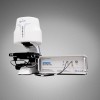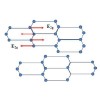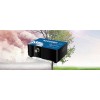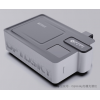Your shopping cart is empty!
Fluorescence Spectroscopy Unveils Carbon Cycle Changes
Fluorescence spectroscopy offers valuable insights into the carbon cycle by detecting enhances our understanding of carbon sequestration, ecosystem health, and climate change, aiding in effective carbon management and environmental monitoring.
Background
Humans, as well as all life forms on Earth, are carbon-based life forms. Carbon cycle changes involve how to effectively address climate change, maintain ecosystem health, implement carbon sequestration and climate policies, optimize agricultural management and land use, and reveal the profound impacts of global changes on production and lifestyle. These areas of change directly influence various industries and technological developments.In tackling climate change, the scientific community explores the details of the carbon cycle, revealing the processes of material production, transformation, and how the Earth conducts carbon cycling. These studies not only answer the question of "where do we come from, and where are we going" but also drive the application of advanced technologies in environmental protection and sustainable development.Regarding technological trends, carbon capture technologies and carbon emission management systems are rapidly evolving. These technologies play a crucial role in addressing global warming and achieving carbon neutrality goals. Meanwhile, carbon cycle optimization and environmental policy adjustments are continually advancing to meet the ever-changing environmental demands.Introduction
Fluorescence spectroscopy, a highly sensitive analytical method, has recently demonstrated unique advantages in revealing carbon cycle changes. The carbon cycle is a critical process in Earth's ecosystem, involving the input, storage, and release of carbon, which has profound impacts on global climate change and ecological balance. Traditional monitoring methods rely on physical-chemical measurements and model predictions, whereas fluorescence spectroscopy, with its high-resolution detection of chemical environments and molecular structures, provides more precise and real-time data support.With the aid of fluorescence spectroscopy, researchers can track the dynamic changes of carbon in plants, soil, and water bodies. Fluorescence signals generated during photosynthesis reflect changes in carbon fixation efficiency, while the organic carbon fluorescence features in soil and water help reveal the carbon transformation processes and their environmental responses. This information is crucial for understanding the complex mechanisms of the carbon cycle, assessing ecosystem services, and formulating strategies to address climate change.By combining fluorescence spectroscopy with other environmental monitoring techniques, scientists can create a comprehensive view of the carbon cycle dynamics, providing strong support for global carbon management and climate policy. Dr. Juliana D'Andrilli, an environmental scientist and associate professor at the Louisiana Universities Marine Consortium in Chauvin, Louisiana, is a key researcher in exploring these insights.Given that human activities such as population migration, agricultural practices, and fossil fuel combustion interfere with Earth's natural carbon cycle and lead to increasingly severe consequences, Dr. D'Andrilli focuses her research on understanding Earth's carbon history and current state. Her work includes predicting future changes through the migration and transformation of carbon-based substances in the ecosystem.
Juliana D'Andrilli, Ph.D.Factors Affecting the Carbon Cycle
The carbon cycle is a complex process influenced by a variety of natural and human activities. Key factors affecting the carbon cycle include photosynthesis and respiration, soil carbon storage and decomposition, deforestation and land use changes, agricultural practices, fossil fuel combustion, industrial activities, wetland changes, and climate change. Each of these elements impacts the intricate mechanisms within the carbon cycle, shaping its dynamics and affecting global carbon management strategies.

Ice Cores: A Breakthrough in Carbon Cycle Research


In a carbon-based world, identifying where to start research on the carbon cycle is a significant challenge. Dr. D'Andrilli believes that ice cores represent a key approach to uncovering the secrets of the carbon cycle. Studying ice cores can reveal Earth's past, making it crucial to understand Earth's history before the ice sheets (continental glaciers) completely disappear. In analyzing the data stored in ice cores, she focuses not only on the Earth's historical climate but also on current changes in the ice layers and their potential implications for the future.Fluorescence spectroscopy provides a groundbreaking insight into ice core samples, revealing that different climatic periods may produce different types of carbon-based substances. In other words, Earth's function and climate are interrelated. As temperatures fluctuate, our carbon productivity also changes, leading to various substances interacting with the atmosphere in the past. These substances were transported to the poles and deposited on the ice sheets. Despite 27,000 years of sedimentation, fluorescence spectroscopy can still "see" these substances through the sealed ice layers.1. Carbon Cycle -- Connecting Biology and the EnvironmentThe carbon cycle facilitates the flow of carbon between biological systems and the environment. But when does this flow begin, and where does carbon ultimately end up? To unravel this mystery, Dr. D'Andrilli has focused on finer details. She explores how microscopic organic matter forms in the ecosystem, flows through different food webs, is utilized by microorganisms, undergoes solar oxidation, and whether it transforms into greenhouse gases. Consequently, dissolved organic matter (DOM) has become a focal point of her research.2. Microscopic Matter at the Base of the Food Chain -- DOMDissolved organic matter (DOM) refers to complex mixtures of organic compounds with intricate compositions, structures, and environmental behaviors. Broadly, it encompasses all organic compounds dissolved in water. As microscopic matter at the base of the food chain, DOM provides energy to organisms and plays a crucial role in carbon transformation, representing one of the largest carbon reservoirs on Earth.3. Hypotheses on Carbon Substance Impact on the EnvironmentDr. D'Andrilli's research project in Louisiana is pertinent to this issue. "Everyone in Louisiana knows that sea levels are rising; every time we step outside, we see the Gulf of Mexico encroaching." Thus, her research focuses on the relationship between humans and the changing distant environment, along with local community education. She connects the changes occurring in remote ice layers, linked through ocean currents, with the lives of coastal communities. Dr. D'Andrilli hypothesizes that carbon substances released from the Arctic ice sheets may impact the environment through two mechanisms:
- Reactions: Chemical properties can be altered through biological or abiotic processes.
- Transport Pathways: Substances may sink to the ocean floor, settle in sediments, or traverse global ocean conveyor belts.
Fluorescence Spectroscopy: Unlocking the Carbon Cycle with Precision
In carbon cycle research, high-sensitivity fluorescence spectroscopy is crucial for Dr. D'Andrilli. Given that she cannot always obtain large samples, especially large ice core samples, she often works with only a small amount of material. “What I love about fluorescence spectroscopy is its ability to deliver big results from small samples,” she says. “With just a small amount of sample and a high-sensitivity instrument tailored for different chemical components, I can achieve significant returns.” She appreciates that this analytical technique requires minimal sample preparation, allowing her to directly characterize chemical substances, species, and unique organic components without the need to handle large volumes of water for measurements.“This also means my work can be highly collaborative. For ice core research, for example, we have to do a lot with limited resources, as we only extract portions of the main ice core and need to share samples with laboratories worldwide. Each researcher only receives a limited number of samples. Many ice core researchers ask, ‘What can we do with such a small sample?’ My answer is that I use light to analyze the sample and identify chemical markers from the data. Once all the data is collected, models emerge, and the story begins. Even a few milliliters of sample can reveal a wealth of carbon data.”Next Steps: Dr. D'Andrilli's research will continue to focus on understanding various microbial carbon-based substances in different ecosystems and using fluorescence technology to determine the sources of different organic compounds and transformations occurring in aquatic networks. She will connect aquatic ecosystems with changing environmental factors such as time, sunlight exposure, temperature, and humidity. Clearly, the first step is to understand how these microbial carbon-based substances change or move in aquatic, terrestrial, and/or atmospheric environments. The next step is to explore what happens when our ecosystems experience irreversible changes, such as global temperature increases, as this is a crucial step in predicting the future.
Search
Categories
Popular Posts
Latest Posts




-100x100.jpg)



















Comments: 0
No comments